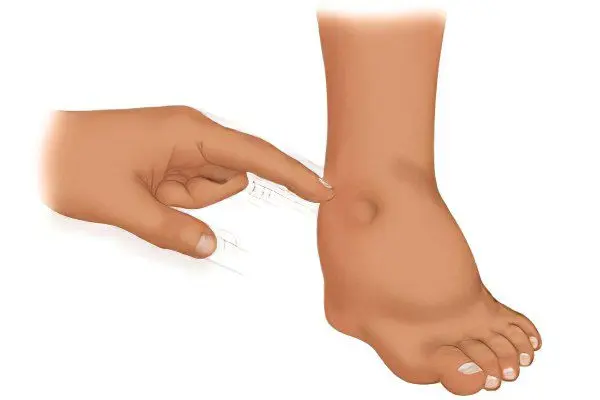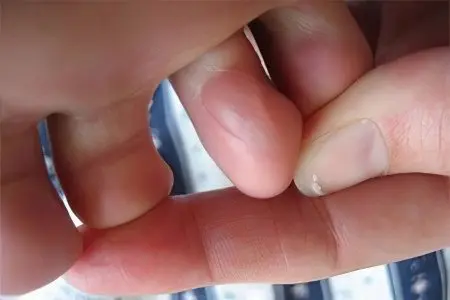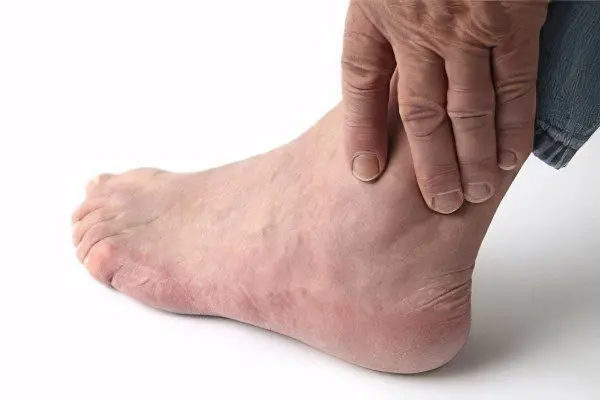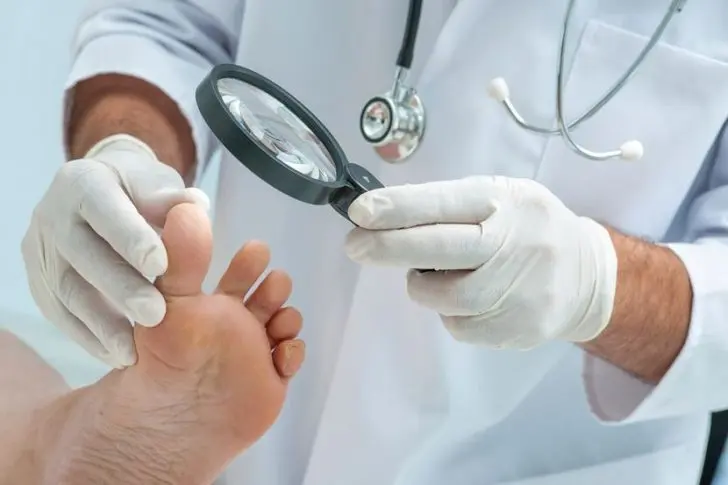Contents
This term hides a symptom of various diseases, expressed in excessive accumulation of fluid in the tissues of the lower extremities. Seeing a doctor with dropsy of the legs is a reason for examining the cardiovascular and urinary systems. Dropsy of the legs can be narrowly localized only in the limbs or is part of a violation of the water balance of the whole body.
How does dropsy of the legs occur?

Dropsy, or edema, occurs due to an imbalance between the flow of fluid into the tissues of the legs and their removal through the venous network or through the lymphatic system. Another cause of dropsy is the increased permeability of blood vessels, their pathological expansion, and, as a result, an increased release of water into the surrounding tissues.
Violation of the osmotic properties of blood is the reason for the appearance of edema of the lower extremities. Violation of blood biochemistry, a decrease in the concentration of sodium, chlorides and proteins, a decrease in the amount of hormones that regulate metabolism, lead to a breakdown in the draining function of the lymphatic and venous systems.
Dropsy is not a separate disease, on the contrary, functional disorders of the cardiovascular system, liver and kidneys are manifested by swelling of the legs.
Causes of severe swelling

Most often, such edema appears when the circulation of lymph and venous blood is disturbed. The outflow of interstitial fluid is impaired in cardiovascular pathologies, diseases of the urinary system, and intoxication.
Causes of dropsy:
Diseases of the lymphatic system of the lower extremities – filariasis, idiopathic elephantiasis. These pathologies stimulate the accumulation of interstitial fluid and problems with its excretion.
Chronic heart failure is a violation of blood pumping and its stagnation.
Thrombophlebitis, blockage of the lumen of the veins by a thrombus.
Violation of water-salt metabolism in pathologies of the thyroid gland (hypothyroidism).
Violation of the osmotic properties of blood, a change in its biochemical parameters due to liver pathologies, starvation, gastrointestinal diseases, nephrotic symptoms.
Venous insufficiency causes stagnation of blood in the vessels of the legs. The constant supply of arterial blood and impaired outflow of interstitial fluid provoke the appearance of severe edema.
Nephrotic syndrome – glomerulonephritis, amyloidosis, pyelonephritis contribute to excessive excretion of protein from the body through the kidneys. Vessels cannot retain water, their walls become more permeable, so the liquid fraction of blood penetrates into the surrounding tissues and accumulates in them, causing dropsy.
Intoxication – the ingestion of toxins from drugs, pesticides, radioactive substances, salts of heavy metals, poisonous gases into the body provoke damage to the organs that regulate blood circulation and blood composition (heart, brain, liver, kidneys).
Arthritis of the knee joints – inflammation of the knee, ankle joints of the legs due to injuries, infections, allergies, tumor and autoimmune factors cause severe swelling.
Causes of edema in combination with pain syndrome

Violation of the outflow of lymph and venous blood, combined with pain, usually provokes an inflammatory process. Edema caused by inflammation occurs with bacterial infection and injury to the limbs.
Causes of dropsy, accompanied by pain:
Filariasis – cause inflammation of the lymphatic vessels and lymphostasis.
Thrombosis of the lower veins – violations of the output of toxic metabolic products provokes their effect on the nerve endings. Metabolites cause inflammation, swelling of the tissues and their soreness.
Myositis – with inflammation of the muscles of the lower extremities, the nerve endings that innervate them are damaged. Muscles become inflamed and increase in size, swell.
Lymphangitis – stagnation of lymph in inflamed vessels irritates the nerve endings, because swollen tissues cause mechanical compression of the nerves.
Fatty edema – the growth of adipose tissue provokes recurrent inflammation in the subcutaneous tissue, the appearance of pain.
Mechanical damage to the limbs – trauma contributes to the damage to the structure and functionality of blood vessels, nerves, skin, muscles of the bones of the leg, which causes an inflammatory process in these tissues. Symptoms include pain and swelling.
Dropsy of the legs in pregnant women

Pregnancy is not the cause of leg swelling in a woman who is expecting a baby. However, changes are taking place in her body that help to adapt to the increased load – this is an increase in blood volume, an increase in venous pressure. If the normal course of adaptation is disturbed, edema appears on the legs.
To increase the volume of circulating blood, the hematopoietic system stimulates an increase in the proportion of plasma. In addition, the influence of progesterone and estrogen cause vasodilation, increasing fluid retention in the body. The colloid-osmotic properties of the blood of a pregnant woman also change, there is an imbalance between the excretion and retention of water in the vascular bed, which causes swelling of the legs.
During an increased load, extragenital pathologies may appear that provoke swelling of the legs:
Heart disease;
Arterial hypertension;
Hepatitis;
Pyelonephritis;
Glomerulonephritis;
Heart failure.
With these diseases, venous blood stagnation and the development of dropsy of pregnant women most often occur.
Preeclampsia, or late toxicosis, provokes excessive secretion of hormones that cause vascular spasm and increased blood pressure. Loss of protein in the urine and impaired permeability of the vascular walls cause blood plasma to leak into the surrounding tissues, causing swelling in the legs. Such swelling is localized on the legs and feet of a pregnant woman, does not cause pain.
Treatment of dropsy of the feet

To eliminate the causes of swelling of the legs, both conservative and surgical methods of treatment are used.
The main conservative methods of treatment:
Treatment with medicines;
Compression treatment;
Physiotherapy.
Drug treatment is the main method of therapy for dropsy of the legs. Medicines eliminate the cause of the disease, act on the mechanism of the appearance of edema, and have a symptomatic effect.
Pharmacological groups of drugs for the treatment of dropsy:
Antibiotics – eliminate pathogenic microflora;
Antiseptics – neutralize the action of pathogenic bacteria;
Antiparasitic drugs – used for filariasis;
Anti-inflammatory drugs – eliminate swelling, pain, reduce the intensity of inflammation;
Anticoagulants – reduce blood clotting;
Fibrinolytics – destroy blood clots;
Diuretics – remove excess fluid from the body through the kidneys;
Cardiac glycosides – stimulate the work of the heart muscle;
ACE inhibitors – lower blood pressure;
Angioprotectors – increase the resistance of blood vessels to damage;
Hepatoprotectors – strengthen the walls of liver cells;
Detoxification agents – remove toxins from the body;
Sclerosing agents – regenerate pathologically dilated veins.
For the treatment and prevention of edema, reducing inflammation, restoring lymphatic drainage, immunostimulation, physiotherapeutic methods are used:
electrophoresis;
Educational therapy;
magnetotherapy,
Massotherapy,
Radon and iodine-bromine baths,
Oxygenotherapy.
To reduce the negative manifestations of dropsy, wearing compression stockings (knee socks, stockings, tights), bandaging the legs with an elastic bandage is used. This method of treatment creates a uniform pressure on the vessels of the lower extremities, does not allow the fluid to move back into the tissues from the vessels.
With the ineffectiveness of conservative methods, surgical treatment of diseases that provoke edema is used:
Installation of a pacemaker, replacement of artificial vessels, heart transplantation in the treatment of heart failure;
Sclerosis and removal of superficial veins in case of varicose veins;
Removal of blood clots in the veins of the legs;
Removal of cysts and tumors of the liver;
Treatment of fractures and wounds resulting from injuries;
Joint puncture for arthritis.
In many cases, a combination of conservative and surgical methods is used to treat dropsy of the legs.









